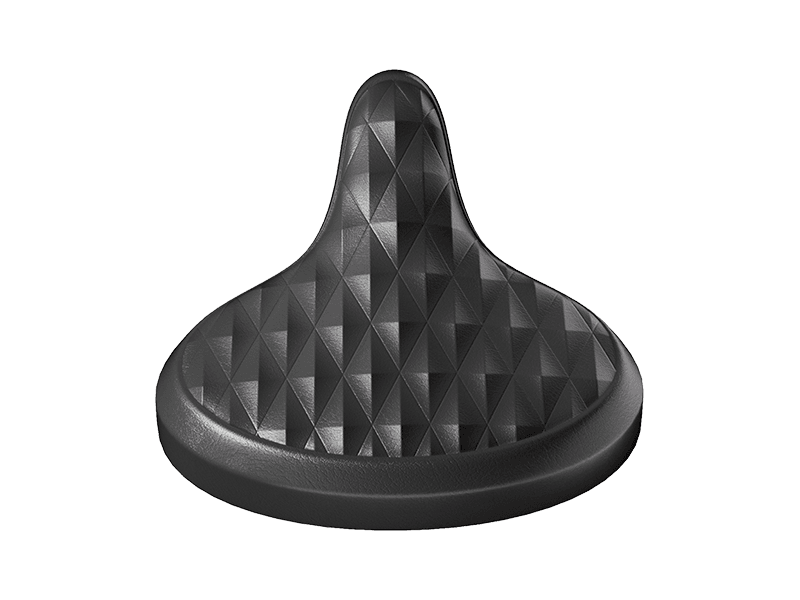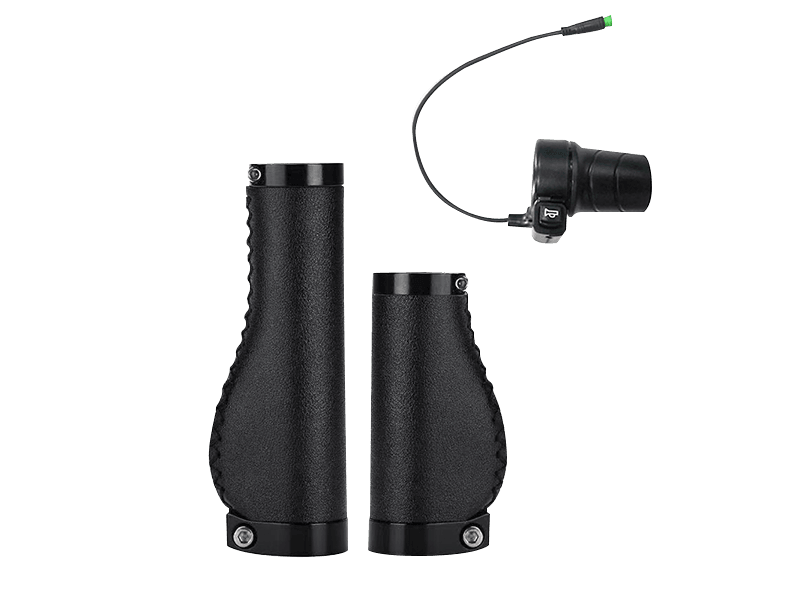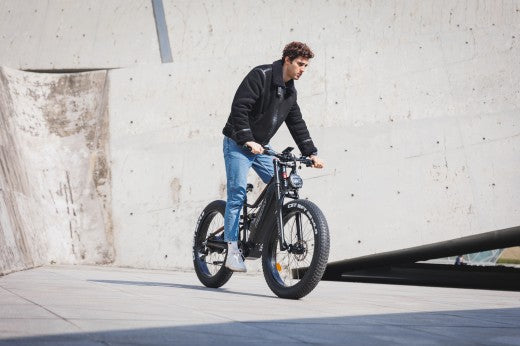FREESKY Blogs
Stay updated with the latest news, tips, and insights on e-bikes, technology, and sustainable riding through the FREESKY blog.
You May Also Like

Oversized Comfortable Saddle

Twist Throttle with Grips (Right-Hand Only)
There's no item in your cart.
You May Also Like
You're Saving C$0.00
Shipping, taxes, and discount codes calculated at checkout.All Topics


This Black Friday, Your Dream E-Bike Might Just Cost $0!
Oct 31, 2025
🏆 FREESKY Black Friday Lucky Rider Event Your Order Might Be FREE! Event Period: November 1 – December 10, 2025 (PST)Where: FREESKY Official Website (www.freeskycycle.com) only 🎯 How It Works 1. First Prize: - One lucky rider who places an order between Nov 1 – Nov 20 (PST) will be selected to win their order for FREE (full refund). - Another lucky rider who orders between Nov 21 – Dec 10 (PST) will also win their order for FREE. 2. Second Prize: - Every 3 days during the event period (PST), one winner will be randomly drawn to receive a US$200 cashback reward. 3. Participation Prize: - Customers who place an order during the event and share their bike photos/reviews publicly will receive a US$30 Gift Card. 🛍️ Who Can Join 1. Open to customers aged 18 or above from eligible regions where FREESKY ships and operates. 2. Valid for purchases made directly on FREESKY’s official website during the event period (PST). 3. Purchases made through third-party retailers, resellers, or marketplaces are not eligible for this giveaway. 4. Participants are responsible for ensuring compliance with local promotional laws. ⚡ Important Notes 1. No additional action is required—simply place your order to join automatically. 2. Refunds and cashback will be issued to the original payment method. 3. FREESKY reserves the right to modify or cancel this promotion in case of unforeseen circumstances. 4. Winners will be announced on FREESKY’s official channels and notified via email. 👉 Ready to roll? Order your FREESKY e-bike this Black Friday — your ride might just be on us! 👉 See the full rules here.
Read More

The Rise of Electric Bikes Transforming Urban Mobility for a Sustainable Future
Oct 20, 2025
Electric bikes are reshaping the way we move through our cities. Combining efficiency, convenience, and eco-friendly design, they are not just a trend—they are a revolution in sustainable transportation. This article explores the benefits of e-bikes, the challenges of adoption, and the future of this fast-growing mobility solution. Why Electric Bikes Are Becoming Essential Across the globe, electric bikes are quickly gaining traction among commuters, outdoor enthusiasts, and eco-conscious individuals. These versatile vehicles seamlessly combine pedal power with motor assistance, making them suitable for city streets, suburban commutes, and weekend adventures alike. The Versatility FactorImagine a bike that effortlessly adapts to your lifestyle: a reliable commuter during the week, a weekend companion for trail exploration, and a practical choice for running errands. Electric bikes offer this flexibility. Their motorized assistance allows riders to travel longer distances and navigate hills with ease, while still promoting an active, sustainable lifestyle. Health and Lifestyle BenefitsE-bikes encourage daily physical activity without overexertion. Pedal-assist technology helps riders gradually increase fitness levels, making cycling accessible to all ages and abilities. By integrating exercise into daily routines, riders improve cardiovascular health, reduce stress, and enjoy more outdoor time—all while reducing reliance on cars. Environmental Benefits of E-Bikes Cutting Carbon EmissionsE-bikes are an environmentally friendly alternative to traditional vehicles. With zero tailpipe emissions and low energy consumption, they help reduce urban air pollution and greenhouse gases. Choosing an e-bike for commuting contributes to a cleaner city environment and promotes sustainable mobility practices. Improving Urban Air QualityCities worldwide face growing challenges with air pollution. E-bikes provide a practical solution by easing traffic congestion and decreasing emissions. As their adoption increases, e-bikes contribute to cleaner air and healthier urban communities. Financial and Health Advantages Cost SavingsE-bikes offer significant financial benefits. Reduced fuel costs, lower maintenance expenses, and no parking fees make them an economical choice compared to cars or motorcycles. Over time, the savings can be substantial while simultaneously supporting environmentally responsible transportation. Boosting Personal Well-beingRiding an e-bike promotes low-impact physical activity. By blending exercise with motor assistance, riders gain cardiovascular benefits, improved mood, and reduced stress. E-bikes also make cycling accessible for longer trips and challenging terrains, encouraging a more active and balanced lifestyle. Tackling Barriers to E-Bike Adoption Addressing Range AnxietyModern e-bikes feature high-capacity batteries and efficient power management, allowing riders to travel longer distances without fear of running out of power. Understanding battery capabilities and proper charging habits helps riders confidently plan extended trips. Prioritizing SafetySpeed management, road sharing, and responsible riding are critical for safety. Wearing protective gear, following traffic laws, and maintaining the bike ensures safe and enjoyable journeys for all. Supporting Infrastructure and Policy Measures Infrastructure DevelopmentWider bike lanes, secure parking, and charging stations make e-bikes more practical and encourage adoption. Cities investing in e-bike-friendly infrastructure create safer, more convenient environments for riders. Government PoliciesSubsidies, tax incentives, and supportive regulations make e-bikes more accessible. Policies that integrate e-bikes into urban mobility plans help reduce congestion, improve air quality, and promote sustainable transportation. The Future of Electric Bikes Innovation in TechnologyAdvanced battery systems, faster charging, GPS tracking, and AI-assisted features are shaping the next generation of e-bikes. Future models may automatically adjust power levels based on terrain and rider behavior, providing an even smarter, more personalized riding experience. Mainstream AdoptionAs technology improves and infrastructure expands, e-bikes are becoming a practical alternative to cars and public transit. They offer a sustainable, cost-effective, and healthy transportation option for cities worldwide. Conclusion Electric bikes are more than a modern convenience—they are a pathway to sustainable, active, and efficient urban mobility. By combining environmental responsibility with health and lifestyle benefits, e-bikes represent a transformative solution for today’s cities. Embrace the e-bike revolution and join a movement that reduces carbon emissions, promotes active living, and delivers endless adventures. The future of urban transportation is electric—and it’s already here.
Read More

Best Moped-Style Electric Bikes 2025 FREESKY Cheetah MT-380 Leads the Pack
Oct 03, 2025
Moped-style electric bikes continue to reshape the e-mobility market, merging motorcycle-inspired design with modern e-bike efficiency. Among the new generation of high-performance models, the FREESKY Cheetah MT-380 stands out as a true all-terrain powerhouse — combining power, range, and comfort like never before. What Makes the FREESKY Cheetah MT-380 Different? At its core, the FREESKY Cheetah MT-380 is engineered for riders who demand real performance. With a Dual 2000W (Total 4000W Peak) motor setup delivering 240Nm of torque, this electric beast can conquer 45° slopes effortlessly. Its 60Ah (2880Wh) removable battery supports up to 200+ miles per charge, redefining what long-range truly means for an e-bike. Design and Comfort The Cheetah embraces the moped-style aesthetic: a full-size cushioned tandem seat, integrated passenger footpegs, and full suspension for 90% vibration absorption. This combination ensures comfort on any surface — from city roads to backcountry trails. Power and Performance - Dual 2000W Motors (4000W Peak) — All-wheel drive system for superior hill-climbing. - Top Speed: 38 MPH — Unlockable for full performance. - 60Ah 2880Wh Battery — Delivers 200+ miles per charge. - Full Suspension — Smooth and stable over rough terrain. Safety and Technology Equipped with quad 4-piston hydraulic brakes, a 1000-lumen LED headlight, and a 3-in-1 smart taillight with turn and brake signals, the Cheetah ensures both visibility and control. The HD display, Type-C charging port, and sine wave controller enhance both user experience and durability. Why Choose a Moped-Style E-Bike Like the FREESKY Cheetah? Moped-style e-bikes bridge the gap between traditional bicycles and full-sized motorcycles. They offer approachable power, low maintenance, and comfortable ergonomics for both solo and two-up riding. The Cheetah embodies these benefits while pushing the performance ceiling far beyond conventional limits. Real Riders, Real Experiences “Absolutely love this e-bike! My partner and I take it out every weekend — the tandem seat is comfortable for both of us, and the built-in speaker makes every ride feel like a mini road trip. It’s not just a bike — it’s our weekend adventure machine!” FREESKY Cheetah MT-380: Key Specifications Feature Specification Motor Dual 2000W (Total 4000W Peak) Battery 60Ah 2880Wh Removable Lithium Battery Range Up to 200+ Miles Top Speed 38 MPH (Unlockable) Torque 240 Nm Brakes 4-Piston Hydraulic Disc Brakes Lighting 1000-lumen Headlight + Smart 3-in-1 Taillight Frame 6061 Aluminum Alloy, Full Suspension Max Load 400 lbs FAQs Is the FREESKY Cheetah street-legal? In most regions, the Cheetah qualifies as a Class 3 e-bike when operated in pedal-assist mode. Higher unlocked speeds may require registration depending on local laws. How long does the battery last? The 60Ah lithium battery can last up to 1,000 full charge cycles with proper care. Each charge provides up to 200+ miles of range depending on terrain and rider weight. Can it carry two riders? Yes. The full-size tandem seat and passenger footpegs are designed for two adults, providing stability and comfort during shared rides. Is maintenance complicated? Not at all. The modular wiring and quick-connect plugs reduce failure rates by 80% and make maintenance up to 60% faster compared to typical e-bikes. Conclusion The FREESKY Cheetah MT-380 isn’t just another moped-style e-bike — it’s a statement of freedom, power, and endurance. Whether you’re exploring rugged trails or cruising through city streets, this machine guarantees an unforgettable ride every time. If you’re searching for the best electric bike that blends comfort, range, and performance, the Cheetah leads the pack. Explore more at FREESKY Official Store.
Read More

7 Best Full Suspension Fat Tire Electric Mountain Bikes in 2025
Sep 19, 2025
7 Best Full Suspension Fat Tire Electric Mountain Bikes in 2025 Welcome, fellow riders, to the electrifying world of mountain biking, where innovation meets adventure! As the popularity of full-suspension fat tire eMTBs continues to soar, riders are seeking the ultimate combination of performance, comfort, and value. In this article, we explore FREESKY's top full-suspension fat tire electric mountain bikes for 2025. What is a Full Suspension Fat Tire E-MTB? A full suspension fat tire e-MTB features both front and rear suspension systems along with wide fat tires, designed to absorb shock and vibrations from rough terrain while providing maximum traction. Combined with an electric motor, this makes your ride smoother, more stable, and capable of handling all terrains. Advantages of Full Suspension Fat Tire E-MTBs - Enhanced Comfort: Full suspension absorbs shocks and vibrations, ensuring a smoother ride on rough trails. - Improved Traction: Fat tires keep more surface contact, offering better grip and stability. - Better Handling & Control: Suspension and fat tires provide precise handling for technical trails. - Increased Versatility & Performance: Adaptable to steep descents and challenging inclines. - Reduced Fatigue: Absorbing bumps allows you to ride longer with less strain. FREESKY Full Suspension Fat Tire E-MTBs Swift Horse Pro X-6E - Price: Now $1,599.00 (was $2,449.00) - Motor: Peak 2500W BAFANG - Battery: 48V 30Ah Samsung Cells, UL 2271 Certified - Top Speed: 38+ MPH - Range: Up to 120 miles - Full Suspension with 4-Piston Hydraulic Disc Brakes - 26" Fat Tires - 5 Riding Modes: Electric, Pedal-Assist, Cruise, Manual, Walk Alaska Pro M-520 - Price: Now $1,849.00 (was $2,649.00) - Motor: 3000W Peak - Battery: 48V 41Ah Dual UL 2271 Certified - Top Speed: 40+ MPH - Range: 90-160+ miles - Full Suspension with Dual 4-Piston Hydraulic Brakes - 26" Fat Tires - 5 Riding Modes: Electric, Pedal-Assist, Dual Motor, Manual, Walk Warrior Pro M-530 - Price: Now $1,849.00 (was $2,699.00) - Motor: Dual Peak 2000W - Battery: 48V 30Ah, UL Certified - Top Speed: 38+ MPH - Range: 40-60 miles (dual motor) - Full Suspension with Colorful Display and 4-Piston Hydraulic Brakes - 26" Fat Tires - Advanced Riding Modes and Safety Features Cheetah MT-380 - Price: Now $2,199.00 (was $3,199.00) - Motor: Dual Peak 2000W - Battery: 60Ah 2880WH Removable - Top Speed: 38+ MPH - Range: Up to 200 miles - Full Suspension AWD Electric Motorcycle Design - 20" Fat Tires - 5 Riding Modes and Smart Display Eurostar Ultra M-410 - Price: $1,299.00 - Motor: 2000W Peak - Battery: 48V 25Ah Samsung Cells - Top Speed: 37+ MPH - Range: Up to 105 miles - Full Suspension with 4-Piston Hydraulic Disc Brakes - 26" Fat Tires - 5 Riding Modes: Electric, Pedal Assist, Cruise, Manual, Walking Mode - Smart LCD Display with Type-C Charging Port Wild Cat Pro A-340 - Price: $1,499.00 - Motor: 2000W Peak - Battery: 48V 25Ah Samsung Cells - Top Speed: 37+ MPH - Range: Up to 105 miles - Full Suspension with Hydraulic Shocks - 26" Fat Tires - 5 Riding Modes: Cruise, Walking Assist, Pedal Assist, Pure Electric, Manual - Step-Thru Frame for Easy Mounting Rocky Pro A-320 - Price: Now $1,299.00 (was $1,499.00) - Motor: 1800W Peak - Battery: 48V 25Ah Samsung Cells - Top Speed: 33+ MPH - Range: Up to 105 miles - Full Suspension with Hydraulic Disc Brakes - 26" Fat Tires - Smart LCD Display with NFC Key - Step-Thru Frame and Cargo Ready Do You Need a Full Suspension Fat Tire E-MTB? Whether you need one depends on your riding style, terrain, and preferences. Full suspension fat tire e-MTBs offer superior comfort, traction, control, and adaptability for challenging trails, steep descents, and off-road adventures. Even for smoother roads, many riders prefer the enhanced stability and ride quality. Conclusion Exploring FREESKY’s full suspension fat tire electric mountain bikes reveals a range of high-performance options suited for beginners and thrill-seekers alike. Choose the model that fits your needs and budget, and embark on your ultimate off-road adventure with confidence.
Read More

Torque vs. Speed: What You Need to Know About Your eBike's Performance
Dec 27, 2024
When it comes to understanding the performance of an electric bike (eBike), two critical factors come into play: torque and speed. Both play vital roles in determining how the bike behaves on the road, but they are distinct concepts that work together to create a smooth and powerful riding experience. In this blog post, we will explore the relationship between torque and speed on an eBike and how they influence your ride. What is Torque? Torque, in simple terms, is the rotational force that propels the wheels of the eBike. It’s responsible for getting the bike moving and helping it climb hills or tackle rough terrains. The more torque your eBike motor produces, the better it can overcome resistance, such as wind, inclines, or rough surfaces. Torque is measured in Newton-meters (Nm) and is an important indicator of how well your eBike can accelerate and perform in various conditions. In an eBike, torque is primarily provided by the motor, though pedaling also contributes to generating force. Typically, motors with higher torque values are more suited for off-road or steep hill-climbing applications. What is Speed? Speed is the rate at which your eBike moves along the ground, typically measured in kilometers per hour (km/h) or miles per hour (mph). The speed of an eBike is influenced by a combination of factors, including the motor's power output, the rider’s pedaling, and the terrain. Speed is often what riders are most concerned about when it comes to performance, as it directly impacts how fast you can travel. However, speed alone doesn't tell the full story of how an eBike performs—it's the combination of speed and torque that really defines the riding experience. How Torque and Speed Work Together While torque and speed are two distinct factors, they are intricately linked. Here’s how they influence each other: Torque Affects Acceleration: When you first start riding your eBike, torque is the primary force that helps the bike accelerate. A motor with high torque provides quick, responsive acceleration, allowing the bike to get up to speed faster. Without enough torque, the bike may struggle to move off the starting line or may feel sluggish, especially on inclines or rough surfaces. Speed Rises as Torque Decreases: As you increase your eBike’s speed, the role of torque diminishes. This is because the motor’s job is to overcome resistance at lower speeds, while at higher speeds, the motor is working to maintain momentum. Once the bike reaches a certain speed, the motor doesn’t need to generate as much torque, and speed becomes more dependent on the power output of the motor. Balance Between Torque and Speed: Ideally, an eBike should offer a balance between torque and speed. Too much torque without enough speed can result in high acceleration but limited top-end performance, while too much speed with low torque may make the bike feel weak or underpowered, particularly on steep inclines or in challenging conditions. Motor Type and Power Output: The type of motor and its power output play a significant role in balancing torque and speed. For instance: Hub Motors: Typically, these motors provide less torque but are more suited for maintaining steady speeds, particularly on flat terrain. Mid-Drive Motors: These motors, positioned at the bike’s bottom bracket, generally offer higher torque, making them ideal for tackling hills and rough terrains while also providing a good balance between speed and acceleration. Rider’s Pedal Input: The rider's pedaling input can also affect the relationship between torque and speed. Pedaling harder can increase the torque available to the motor, thus helping to accelerate or climb hills more easily. Conversely, when cruising at higher speeds, less pedal force is required to maintain momentum, allowing the motor to focus on speed rather than torque. Real-World Example Imagine you’re riding up a steep hill on your eBike. In this case, the motor needs a lot of torque to overcome gravity and move the bike forward. However, as you reach the top of the hill and start cruising on a flat road, you don’t need as much torque anymore. Instead, the motor’s focus will shift toward maintaining speed while you continue to pedal or coast. On the other hand, if you’re riding at high speeds on a flat road, torque becomes less of a concern, and your motor will work more efficiently to maintain speed without putting as much strain on the system. Conclusion In summary, torque and speed are closely related but serve different purposes on an eBike. Torque is essential for acceleration, hill climbing, and overcoming resistance, while speed represents how fast the bike travels. The key to an enjoyable and efficient eBike experience lies in finding a motor that provides the right balance between these two factors, depending on your riding style and the terrain you frequent. Whether you need more torque for off-roading or more speed for commuting, understanding the relationship between these elements will help you make an informed decision when choosing your next eBike. If you’re in the market for an eBike, consider both torque and speed to ensure the bike matches your specific needs. With the right combination, you’ll enjoy smoother, faster, and more enjoyable rides every time you hit the road.
Read More